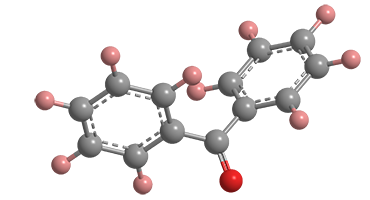What molecule am I?


Benzophenone, also called diphenyl ketone, is the simplest diaromatic ketone. In an early literature report (1874), Carl Graebe at the University of Königsberg (Prussia) described the reduction of benzophenone with hydroiodic acid and elemental phosphorus to form diphenylmethane1.
Benzophenone is a white, low-melting solace with a roselike odor. Methods for synthesizing it include the aluminum chloride–catalyzed Friedel–Crafts reaction between benzene and benzoyl chloride and the decarboxylation of 2-benzoylbenzoic acid2 in the presence of a copper catalyst.
Benzophenone’s current and former uses include as a perfume fixative and in the manufacture of drugs and insecticides. It also emerged in photochemistry, as described in two recent reports.
In 2019, Ravi Kumar Venkatraman and Andrew J. Orr-Ewing at the University of Bristol (UK) reported that the photochemical behavior of benzophenone in solution varies depending on solvent makeup. The authors irradiated a solution of benzophenone in dichloromethane solution in the presence or absence of phenol. Hydrogen bonding between triplet-state benzophenone and phenol accelerated the hydrogen-atom abstraction reaction, shifting the UC–vis and FTIR spectra of both components. Femtosecond time-resolved absorption spectroscopy was used to observe the solvatochromic shifts.
Then last year, Andrew D. Smith, Eli Zysman-Colman, and colleagues at St. Andrews University and Astra Zeneca (Macclesfield, both in the UK) took advantage of benzophenone’s low-lying triplet state to use it as an effective, inexpensive sensitizer in a [2 + 2] photochemical cycloaddition step in the synthesis of dimethyl cubane-1,4-dicarboxylate3. In this step, an acetonitrile solution of a dibromotricyclodienedione with a substoichiometric amount of benzophenone was irradiated at 390 nm to rearrange the substrate to a tetracyclic dibromodione that was the forerunner of the eventual cubane derivative.
1. CAS Reg. No. 101-81-5.
2. CAS Reg. No. 85-52-9.
3. CAS Reg. No. 29412-62-2.
Benzophenone hazard information*
| Hazard class** | GHS code and hazard statement | |
|---|---|---|
| Acute toxicity, oral, category 4 | H302—Harmful if swallowed | |
Serious eye damage/eye irritation, category 2B | H320—Causes eye irritation | |
| Carcinogenicity, category 1A | H350—May cause cancer | |
| Specific target organ toxicity, repeated exposure (oral, liver, kidney, blood system, bone marrow), category 2 | H373—Causes damage to organs through prolonged or repeated exposure | |
| Short-term (acute) aquatic hazard, category 1 | H400—Very toxic to aquatic life | |
| Long-term (chronic) aquatic hazard, category, category 1 | H410—Very toxic to aquatic life with long-lasting effects. | |
*Compilation of multiple safety data sheets; in each class, the most hazardous category is shown.
**Globally Harmonized System (GHS) of Classification and Labeling of Chemicals. Explanation of pictograms.
MOTW updates
Thalidomide1 was the Molecule of the Week for September 2, 2014. It is a drug introduced in the 1950s primarily for treating morning sickness in pregnant women. Tragically, it turned out to be a teratogen that caused about 10,000 infants worldwide to be born with phocomelia, or limb malformation. In later years, thalidomide was approved for treating cancer and leprosy.
In a recently published book, The Malta Thalidomide Affair, author Anatole Baldacchino, a prominent Maltese certified public accountant and member of several government boards of directors, writes about how slowly and poorly the Maltese government responded to the thalidomide crisis in that country. (Baldacchino has a personal stake in this story; he was born with relatively mild phocomelia.) The catastrophe came at a time when Malta was experiencing political, social, and religious upheaval. In January, The Dispatch, an American online magazine, published an article with a brief review of the book plus other troubling information about the thalidomide scandal.
Dichlorodiphenyltrichloroethane2 (DDT) was the Molecule of the Week for December 13, 2021. It was once the preeminent insecticide for agricultural and domestic use; but it was soon recognized as an acute and chronic toxin and a persistent environmental pollutant. It was banned in the United State in 1972 and worldwide in 2004.
But we haven’t seen the last of DDT. Last month, David L. Valentine and collaborators at the University of California, Santa Barbara, Oleolytics LLC (State College, PA), and the University of Southern California (Los Angeles) reported the results of a study of DDT contamination in deep San Pedro Basin sediments between the Port of Los Angeles and Catalina Island. Their findings indicated that
- bulk DDT waste disposal peaked in the 1950s;
- much of the waste is outside designated disposal areas;
- the waste includes substantial amounts of the DDT “daughter product” dichlorodiphenyldichloroethane (DDE)3;
- much of the waste was not disposed of in containers; and
- the company that dumped DDT also dumped low-level radioactive waste.
1. CAS Reg. No. 50-35-1 (racemic).
2. CAS Reg. No. 50-29-3.
3. CAS Reg. No. 72-54-8.
This molecule was suggested by a reader. We present almost all of the molecules suggested by our readers. If you have a molecule you would like us to consider, please send us a message. And thank you for your interest in Molecule of the Week! —Ed.
Benzophenone
fast facts
| CAS Reg. No. | 119-61-9 |
| CA Index Name | Methanone, diphenyl- |
| Empirical formula | C13H10O |
| Molar mass | 182.22 g/mol |
| Appearance | White crystals or powder |
| Melting point | 48.5 °C |
| Water solubility | ≈140 mg/L (25 °C) |

Learn more about this molecule from CAS, the most authoritative and comprehensive source for chemical information.
Molecule of the Week needs your suggestions!
If your favorite molecule is not in our archive, please send us a message. The molecule can be notable for its current or historical importance or for any quirky reason. Thank you!
Stay Ahead of the Chemistry Curve
Learn how ACS can help you stay ahead in the world of chemistry.

